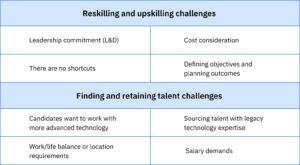Closing the 2023 IT skills gap
In this article, we discuss closing the 2023 IT skills gap. It examines strategies, technologies, and initiatives aimed at bridging the gap between demand and availability of IT skills.

The global IT skills gap is increasing at an alarming rate, with projections indicating a 3.5 million-person shortage of IT professionals worldwide by 2023.
This growing skills gap has enormous implications for businesses and countries alike, as IT continues to become more integrated into every aspect of our lives.
Many countries are already taking concrete steps to address the issue and prepare for a future in which the need for skilled IT professionals is evident.
This article will explore the 2023 IT skills gap, how it impacts businesses, the challenges of addressing it, and how it can be addressed.
What is the IT skills gap?Copied
The IT skills gap refers to the difference between employers’ desired levels of technical proficiency and actual employee ability.
The importance of this divide has been accelerated by rapid technological advancements, especially in areas such as automation, cloud computing, big data analytics, and artificial intelligence (AI).
As organizations demand more advanced technical capabilities within their workforce, they need help to fill these roles with existing personnel, with a CIO report finding that 86% of organizations anticipate challenges in hiring individuals with expertise in on-premises technologies.
Moreover, 75% IT decision-makers reported gaps in their IT staffs’ skills, an increase of 145% since 2016.
This growing problem leads to increased stress, lengthy project durations, higher operating costs, and decreased ability to meet business objectives. The United States, for example, expects to lose more than $162 billion by 2030 due to sector skills shortages.
As technology continues its rapid evolution, organizations must meet ever-increasing demand for technically proficient personnel. As a result, businesses must devise effective strategies for bridging the divide between desired levels of technical proficiency and actual employee abilities.
The impact of the IT skills gap on businesses Copied

The IT skills gap has had a massive impact on businesses worldwide, but what are its effects?
Team member burnout
With the growing IT skills gap, organizations are feeling pressure to do more with less.
A JetRockets survey paints a stark picture: nearly 40% of respondents said they feel burnt out or need more resources and support to do their jobs. This strain on employees is further compounded with 45% of tech leaders planning on cutting their 2023 budgets.
These issues can have a detrimental effect on team morale and overall business performance.
Decrease in output quality
The impact of the IT skills gap on business is strikingly evident in Monster’s survey, which revealed that 45% of respondents believe it influences work quality.
The problem intensifies with an overworked and anxious IT team, which, hamstrung by outmoded skill sets, needs to deliver excellent service.
Furthermore, a team focused on solving problems leaves less time for innovation, and customer satisfaction needs to improve. Customer satisfaction can be influenced by decreasing the quality of the products or services and availability and reliability of the customer’s support. Ultimately, resulting in decreased revenue for the business.
So it’s a double-edged sword; time spent mastering essential skills leaves fewer resources to generate creative ideas and explore new horizons.
Employee turnover
The cost of annual employee turnover continues to rise, with 48% of U.S. hiring managers admitting to increased turnover in their companies, according to a survey from The Harris Poll.
This can be attributed to several factors, with one of the major contributors being skills gaps impeding an IT professional’s job performance.
In addition, employees who don’t feel supported by their organization because it isn’t investing in their development are much more likely to take their talents elsewhere.
Not only does this mean that organizations risk losing critical skills and institutional knowledge, which can be difficult, time-consuming, and costly to replace, but it also makes it incredibly hard for decision-makers to fill high-priority IT roles due to a lack of qualified candidates.
Cybersecurity risks
Cybersecurity is one of the most critical hiring considerations for companies today, and the lack of professionals in the area has become a significant challenge.
According to an (ISC)2 report, this global shortage could exceed 2.9 million people, a figure that organizations must take seriously to stay ahead of the curve regarding data security.
Delayed launches & migrations
As the business world continues to modernize, cloud transformation has become essential for many organizations, bringing with it a host of new challenges.
The most difficult of these is the need for more skilled professionals. Unfortunately, 34% of business leaders note this shortage is reducing their ability to operate and launch services, meaning companies risk being left behind compared to their competitors.
As a result, organizations must be diligent when implementing any significant digital change.
The challenges of addressing the IT skill gapsCopied
The 2023 IT skills gap is growing. Organizations need to focus on closing these gaps, but this is easier said than done. So what makes overcoming the IT skills gaps so challenging? Let’s take a look.
Reskilling and upskilling challenges
Leadership commitment (L&D)
Without the commitment and involvement of leadership, successful L&D programs designed to address these gaps are unlikely to succeed.
According to research by McKinsey & Company, executives should not just set an example for employees about participating in L&D courses, but should engage as trainers, facilitators, or learners.
The buy-in from leadership and the modeling of the same behavior asked of employees has proven paramount in successfully addressing skills gaps.
Cost consideration
Skills gaps in the workforce can be costly to close, and the return on investment isn’t always what employers expect.
For example, despite spending over $350 billion on corporate learning and development initiatives each year, 75% of senior managers report being dissatisfied with the results.
There is no guarantee that employees will complete training programs or courses, and there may be additional costs that come alongside them, such as paying for certifications or licensing fees.
Furthermore, there is no guarantee that a training program will address the skills gap effectively. Measuring whether a training program has improved staff performance can be difficult in the long run.
There are no shortcuts
Businesses need help striking a balance between retaining existing employees and sourcing new talent.
According to estimates from the World Economic Forum, this is compounded by the fact that 50% of all employees will require reskilling by 2025 due to the adoption of new technology.
To be successful, organizations must put into place a detailed process that involves planning, developing, and implementing new infrastructures for employee retraining.
McKinsey’s research has found that those who implement this approach have a nearly 100% chance of successful skill transformation – 2.5 times higher than those who fail to do so.
Defining objectives and planning outcomes
Upskilling and reskilling employees have become urgent tasks for executives, as digitalization demands fast-paced organizational changes, with 70% of employees still needing to improve on the skills needed to do their jobs effectively. This points to the challenging task that learning and development teams face in providing tailored training programs that accommodate individual learning needs and abilities.
Closing the 2023 IT skills gap is a complex process that requires a significant commitment of time, effort, and money from employers and employees.

Finding and retaining talent
Talent is one of any business’s most valuable assets. Finding and retaining the right talent in a competitive labor market, however, is not always an easy task.
Here are four significant challenges to consider when searching for new employees.
- Candidates want to work with more advanced technology.
Many candidates are looking for jobs where they can work with more advanced technologies, such as artificial intelligence (AI), machine learning (ML), and the internet of things (IoT).
If your business does not offer these types of opportunities, it may be challenging to attract top talent away from other organizations that provide them.
- Sourcing talent with legacy technology expertise
Many companies still use older technologies. While there may be a few experienced professionals with expertise in these legacy technologies, they are becoming increasingly rare as time passes by.
This makes it difficult for businesses to find qualified candidates with the knowledge and experience necessary to maintain these older systems.
- Work/life balance or location requirements
Candidates often have specific demands regarding work/life balance and job location.
For example, some potential employees may demand flexible hours or remote working options, while others only want jobs close to home or family members.
This can make it challenging to find suitable employees who meet your criteria, while providing them with a workplace environment that also fits their lifestyles.
- Salary demands
Depending on the type of position you are trying to fill and the salary expectations of your target candidate pool, finding someone willing to accept what you can offer them financially and professionally can be challenging.
How to address the 2023 IT skills gapCopied
- Identify the existing 2023 IT skills gap in your organization. By mapping out the skills present within your staff, you can more easily bridge any gaps.
To do this, create an accurate skills matrix of your staff members’ abilities and competencies to help you identify precisely which skills need more development or support.
- Identify what skills are needed to help close this gap and ensure that current employees have the necessary knowledge to fill these positions.
In addition, it is essential to recognize the adjacent skill sets that may be beneficial in driving overall success. This means understanding the larger picture well, and recognizing other duties that may intersect with a particular position or job function.
- Create an individualized learning plan for each employee that is tailored to their unique skills and needs. This will ensure that your staff is prepared for several future roles.
Furthermore, by embedding these learning plans into a career portfolio for each employee, potential new talent can view training opportunities within your organization and be motivated to join them.
This helps retain existing staff, and can also provide your company with an edge over competitors when attracting the best talent in the industry.
- Establish a budget for upskilling initiatives, such as training programs or certifications. Investing in upskilling initiatives is a sound financial decision for any organization.
By setting up a budget for training programs or certifications, you can offer valuable resources to help keep employees engaged and challenged – boosting staff morale and ultimately reducing turnover and burnout.
Moreover, it shows that your organization is dedicated to cultivating a learning environment and will continue to invest in the professional development of its team members.
- Develop a comprehensive recruitment strategy to attract suitable IT candidates.
Using a skills-based approach and leveraging global talent pools can be beneficial when looking outside the local market. Employers should always consider candidate salary expectations, lifestyle requirements, and any other criteria that build towards a desired culture fit.
By having an inclusive and targeted plan in place when recruiting for a new position, employers can work to acquire the most qualified candidates in terms of technical abilities and company dynamics.
- Automate to close the gaps by adopting automated tools to bridge the IT skills gap.
These tools provide an effective and efficient way to manage large-scale operations with minimal hands-on involvement.
Automation solutions have allowed businesses to sidestep the need for manual workarounds, better utilize their resources, and improve operational accuracy.
For example, skills management software provides businesses with more accuracy and precision when tracking skills development within a company. As a result, IT businesses can ensure that teams utilize their resources most effectively and operate most efficiently.
- Invest in comprehensive onboarding and an ongoing mentoring program to give employees the boost they need to succeed.
New hires can quickly learn the ropes thanks to pre-planned onboarding. Mentoring, meanwhile, is key in fostering longer-term growth and development skills.
Offering ongoing education opportunities through mentorship helps nurture existing talent and attract new and innovative minds who thrive in continual learning.
These two initiatives work together to form a dynamic opportunity for organizations to maximize employee engagement and productivity.
- Establish an employee recognition program to reward those who demonstrate initiative in upskilling themselves and take advantage of available resources.
An employee recognition program that recognizes those who put forth extra effort benefits both parties, and can help create a unified workplace.
This mutually beneficial partnership provides employees with greater job satisfaction, leading to higher performance levels and retention rates within an organization.
Close the 2023 IT skills gap with the AG5 solutionCopied
The complexities of today’s IT landscape require a fresh approach to managing employee skills and training.
AG5 Skills Management Software is an excellent solution that organizations can leverage to build a more skilled workforce, track employee development, and comply with industry regulations.
With its impressive array of features, such as the expert finder, gap analysis list, and global/local skills management capabilities, AG5 provides companies of any size with a powerful tool for bettering their day-to-day operations. Read how AG5 can help close the IT skills gap and drive organizational progress.
ConclusionCopied
Closing the 2023 IT skills gap is a multifaceted challenge that requires employers to take proactive measures to ensure their workforces have access to the best training and resources available.
For any organization looking to stay ahead of the competition and acquire the best available talent, it’s critical to invest in comprehensive recruitment and onboarding strategies, leverage automation solutions wherever possible, and establish employee recognition programs.
By combining these initiatives with the power of AG5’s skills management software, you will be well-equipped to close the 2023 IT skills gap. So schedule your free demo today!

